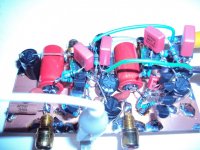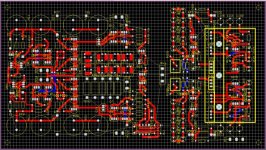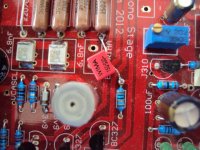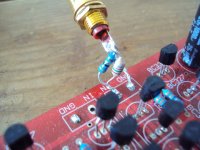She has listened to the Paradise the way it came from Hesener. Problem is that i have a lot of phonostages that sound exceptional.
No problem at all just send them to me 😀
What i can say is that the redesign of the current mirrors brought higher dynamics and resolution. I send the boards back to Hesener so he can compare too.
What i can say is that the redesign of the current mirrors brought higher dynamics and resolution. I send the boards back to Hesener so he can compare too.
Nice evolutions 🙂
What do you think about the strain gauge ? http://www.sound-smith.com/cartridges/images/soundsmith_007.jpg
Quote"No "RIAA" filter circuitry is required or used in our preamp - just one ULTRA clean gain stage (this is because the Stgrain Gauge is a "displacement" device, not a "velocity" sensitive device like magnetic cartridges"
Quote"No "RIAA" filter circuitry is required or used in our preamp - just one ULTRA clean gain stage (this is because the Stgrain Gauge is a "displacement" device, not a "velocity" sensitive device like magnetic cartridges"
Last edited:
Ricardo, straingauge without any equalisation will have an uncorrected pole and zero in the midrange. Likely a cartridge like the Win will sound more transparent because there is a rise to the higher frequencies. I have published unequalized FRDs of the Panasonic.
That can be very exiting at first but tyring in the end. The RIAA curve is simply not a perfect replica of a transducer like this. Small changes in FRD can have a tremendoes effect on the sound. You know that of cause.
That can be very exiting at first but tyring in the end. The RIAA curve is simply not a perfect replica of a transducer like this. Small changes in FRD can have a tremendoes effect on the sound. You know that of cause.
She has listened to the Paradise the way it came from Hesener. Problem is that i have a lot of phonostages that sound exceptional.
what, my babies did not sound exceptionallier than exceptional?
(tell me about correct spelling..... ;-)))
Well, i think they sound so natural that you forget about the technology and start to listen to the music.
Hehe... I know about that feeling 🙂Well, i think they sound so natural that you forget about the technology and start to listen to the music.
I got the new Elektor and there is a phono stage by Douglas Self. It is very similar to his 1996 precission preamp. The MC input stage has one transistor more and runs on higher current ( around 7 mA ), that is good for low impedance cartridges. The transistors are now 2SA1085 instead of the hard to get Rohms.
He has now put the gain ranging in the output stage so he needs one opamp more.
From MC in to line the signal travels through one switch, two connectors, one discrete stage, 4 opamps plus 3 colateral opamps, 8 caps, 5 of them electrolitics and one of the electrolytics in the feedback path. That is a lot of stuff but did not hinder great specs. You can see it as you will, eather as not audiophile or so wise and experienced that it simply does not matter and frees up a lot of time and thinking space. He even puts an elcap behind the MC stage although there is a servo.
I have build his MM stage in modified form many times ( JG-Self RIAA ) and it is dead accurate like a passive but with the advantage of 14dB more dynamic range in the treble. From the traditional, series feedback based circuit, this is one of the best.
I never have build his MC head so i did that today. Of cause i made some changes. I took out the Elcap at the outout, it is not needed. Istead of an NE5532 i used an OPA1641 and the servo is not a TL071 but and LF411. I used very good passive parts, the input cap is a Black Gate for example shunted with a PPS. In result this stage works very well. It is very low noise and sounds very even without grain and sharpness. Space is great too. I would say an underrated design that deserves more attention. OK, it is not very innovative except the shunt bias of the input transistors. I have seen circuit like that that trace back into the late 60th. On the other hand it is a mature and sound design, compact, inexpensive, easy to build and efficient. I like it as a quick fix and also for much more.
He has now put the gain ranging in the output stage so he needs one opamp more.
From MC in to line the signal travels through one switch, two connectors, one discrete stage, 4 opamps plus 3 colateral opamps, 8 caps, 5 of them electrolitics and one of the electrolytics in the feedback path. That is a lot of stuff but did not hinder great specs. You can see it as you will, eather as not audiophile or so wise and experienced that it simply does not matter and frees up a lot of time and thinking space. He even puts an elcap behind the MC stage although there is a servo.
I have build his MM stage in modified form many times ( JG-Self RIAA ) and it is dead accurate like a passive but with the advantage of 14dB more dynamic range in the treble. From the traditional, series feedback based circuit, this is one of the best.
I never have build his MC head so i did that today. Of cause i made some changes. I took out the Elcap at the outout, it is not needed. Istead of an NE5532 i used an OPA1641 and the servo is not a TL071 but and LF411. I used very good passive parts, the input cap is a Black Gate for example shunted with a PPS. In result this stage works very well. It is very low noise and sounds very even without grain and sharpness. Space is great too. I would say an underrated design that deserves more attention. OK, it is not very innovative except the shunt bias of the input transistors. I have seen circuit like that that trace back into the late 60th. On the other hand it is a mature and sound design, compact, inexpensive, easy to build and efficient. I like it as a quick fix and also for much more.
Attachments
Last edited:
Here is a picture of my build. It is quite compact.
The ouput stage is a bit unusual. DS burns around 5/6 of the voltage swing in a resistive devider that gives an acceptable load to the opamp and gives a low output impeance. I would use a buffer and a current source on the input transistors. That way an all in one go RIAA can be made. I build something like that with Fets at the input that workes very well.
I think he does that because this stage has lots of gain and is not easy to stabilize. With the values i use plus my different opamp i had to raise the compensation cap to 43pF. With Selfs 10pF it oscillated.
The ouput stage is a bit unusual. DS burns around 5/6 of the voltage swing in a resistive devider that gives an acceptable load to the opamp and gives a low output impeance. I would use a buffer and a current source on the input transistors. That way an all in one go RIAA can be made. I build something like that with Fets at the input that workes very well.
I think he does that because this stage has lots of gain and is not easy to stabilize. With the values i use plus my different opamp i had to raise the compensation cap to 43pF. With Selfs 10pF it oscillated.
Attachments
Actually the 470uF cap at the input is grossly oversized because the input impedance of this stage is rather high. You can use foils if you will, Wima makes very small 10uF MKTs for example.
Here is a 4,7Uf and it is not even expensive. MKS-2-5 4,7µ - WIMA Folienkondensator, Rm 5mm, 4,7µF bei reichelt elektronik
I got the new Elektor and there is a phono stage by Douglas Self. It is very similar to his 1996 precission preamp. The MC input stage has one transistor more and runs on higher current ( around 7 mA ), that is good for low impedance cartridges. The transistors are now 2SA1085 instead of the hard to get Rohms.
He has now put the gain ranging in the output stage so he needs one opamp more.
From MC in to line the signal travels through one switch, two connectors, one discrete stage, 4 opamps plus 3 colateral opamps, 8 caps, 5 of them electrolitics and one of the electrolytics in the feedback path. That is a lot of stuff but did not hinder great specs. You can see it as you will, eather as not audiophile or so wise and experienced that it simply does not matter and frees up a lot of time and thinking space. He even puts an elcap behind the MC stage although there is a servo.
.
Saw that too, I think its a lot of components... Paradise is a good example of how that can be achieved with much less components, and in my opinion much more elegant. But I am not a phono stage designer at the level of you or Self, so who am I to tell....
This is what "Paradise regained" looks like right now. Schematic is captured, placement of components done, routing has started. This now has the current source on the left side, input stage in the middle, the RIAA elements and current source next to it and very close, and the output buffer. The servo is at the bottom in the middle, close to the buffer. The shunt regs are where they were before. Board dimensions are the same as before. More as it progresses.....
Attachments
I have now bootstrapped the Paradise buffer with a 150pF and added an input filter of 1,2uH parallel with 47 Ohm. I will now measure it in the lab.
I have being working with Mad on the High Speed Preamp and the Power Buffer plus Cap Multiplyer. The layouts are ready and after Beta Testing we will publish the Gerbers.
I have being working with Mad on the High Speed Preamp and the Power Buffer plus Cap Multiplyer. The layouts are ready and after Beta Testing we will publish the Gerbers.
Did not help. At least i get a signal out of one of them overlayed with the 40MHz. This gets tough.



